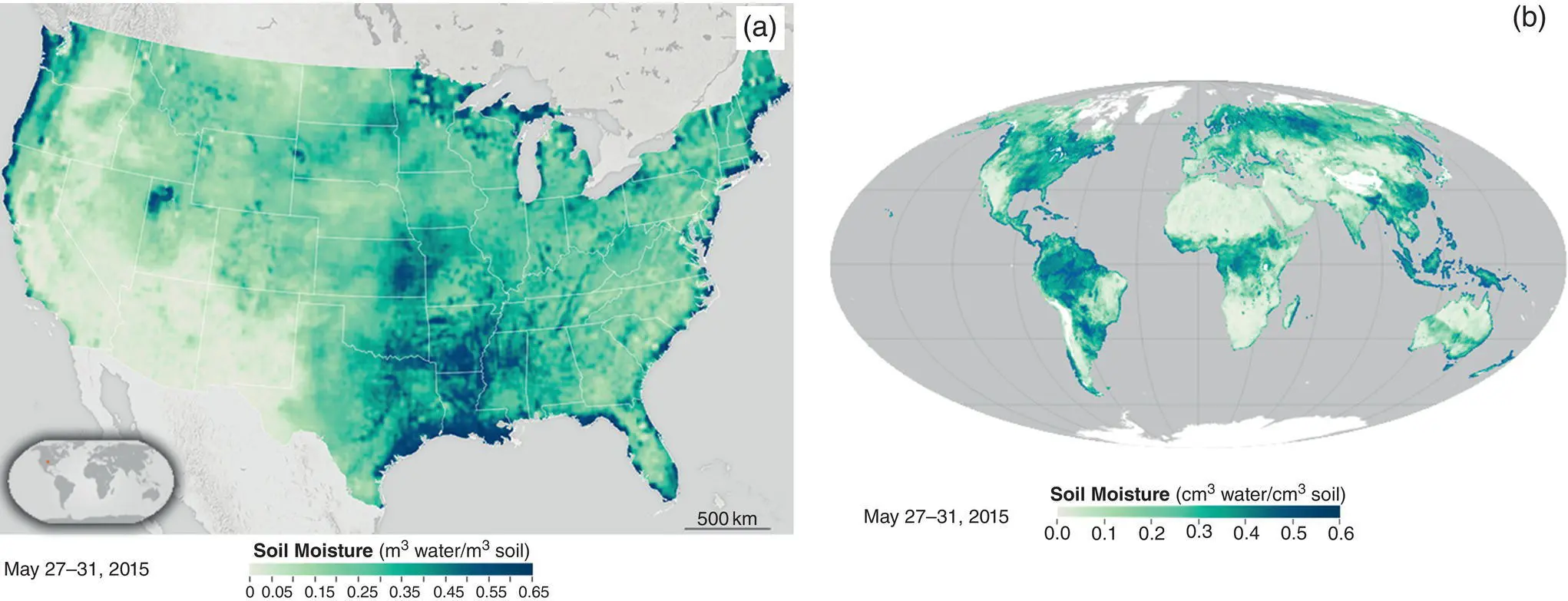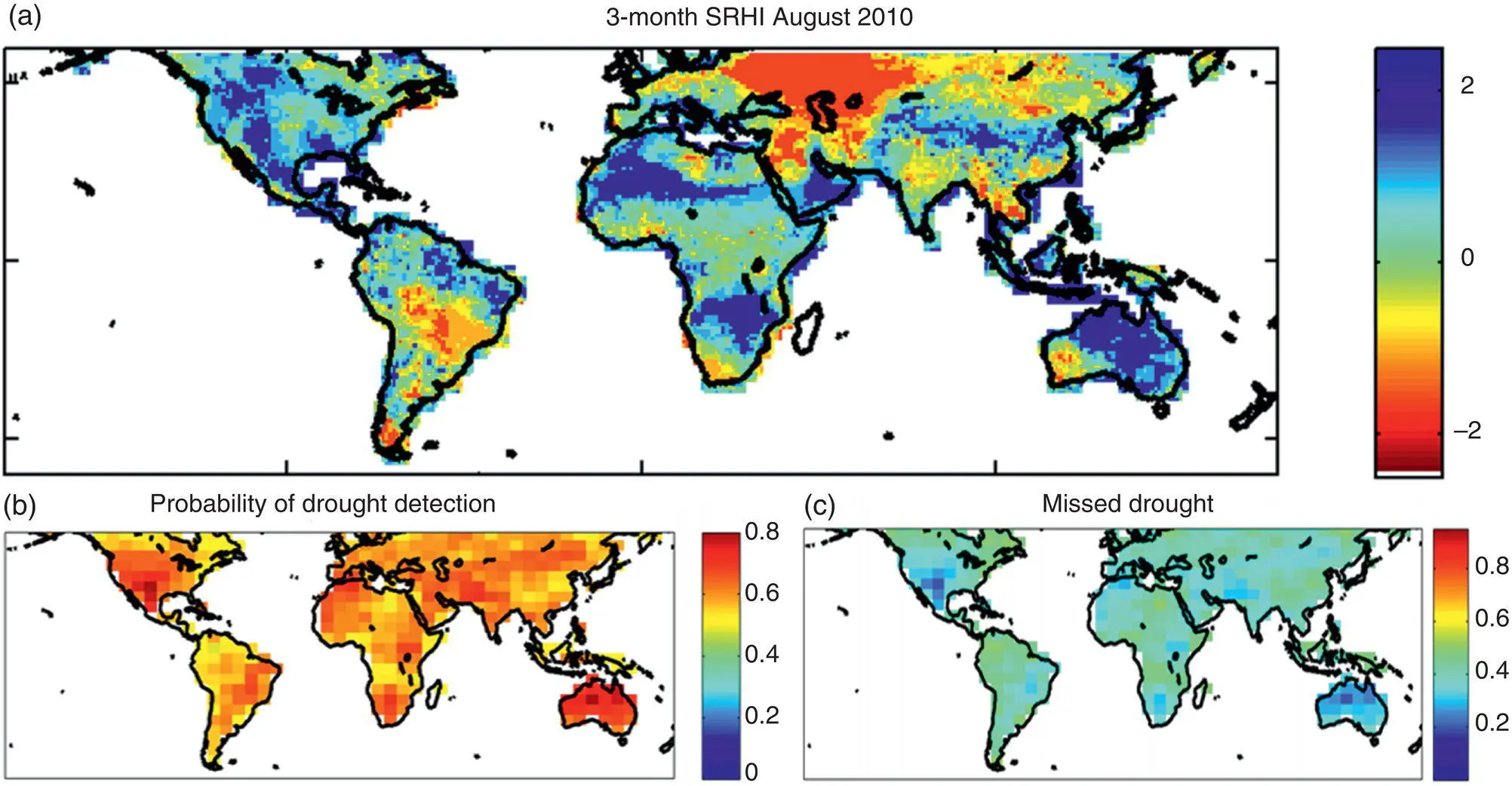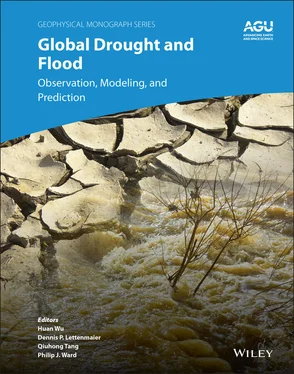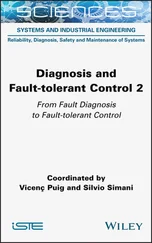1 ...7 8 9 11 12 13 ...39 
Figure 1.4 Soil moisture observation by NASA’s Soil Moisture Active Passive (SMAP) satellite. (a) Soil moisture observation of the United States. (b) Global view.
(Courtesy of NASA’s earth observatory: https://earthobservatory.nasa.gov/images).
Monitoring agricultural drought requires high‐resolution data to reveal detailed variations of soil moisture. To improve the spatial resolution of soil moisture data, several downscaling methods have been used, such as machine learning frameworks (Im et al., 2016; Park et al., 2017), DISaggregation based on Physical And Theoretical scale CHange (DISPATCH) which uses shortwave and thermal data from Moderate‐Resolution Imaging Spectroradiometer (MODIS) to downscale SMOS data (Merlin et al., 2015), and Smoothing Filter‐based Intensity Modulation (SFIM) which integrates microwave data from SMAP, Sentinel‐1, and AMSR2 to downscale soil moisture data to an enhanced resolution of 0.1° × 0.1° (Santi et al. 2018).
Water vapor has a significant influence on Earth’s climate and energy distribution as it displaces nearly half the trapped heat in an upward and poleward direction and is considered a natural greenhouse gas (Sherwood et al., 2010). Advances in remote sensing have made it possible to monitor water vapor and relative humidity through satellite sensors. Relative humidity is defined as the amount of water available in air with respect to the required water vapor for saturation at a specific temperature. Remotely sensed relative humidity data can be used as an early detection variable to monitor drought (Farahmand et al., 2015). A recently proposed Standardized Relative Humidity Index (SRHI) offers potential information about early drought detection and can be used in conjunction with other indices such as SPI or the Palmer Drought Severity Index (PDSI; Palmer, 1965) for drought monitoring and early warning systems (Farahmand et al., 2015; Figure 1.5). Studies also show that a combination of near‐surface air temperature, vapor pressure deficit, and relative humidity can enhance the detection of drought onset (Behrangi et al., 2016). To detect onset of drought, Farahmand et al. (2015) used the Atmospheric Infrared Sounder (AIRS20) satellite’s relative humidity data and developed a SRHI. The AIRS mission provides relative humidity data with a spatial resolution of 1° and covers a period ranging from 2002 to present. The authors suggested that due to the limited period of recorded data from AIRS for the purposes of drought analysis (< 30 years), the Gravity Recovery and Climate Experiment (GRACE) observations, Evaporative Stress Index data, and a combination of AIRS and reanalysis data sets could be used to extend the observation records.

Figure 1.5 Standardized Relative Humidity Index (SRHI) for (a) August 2010, (b) probability of drought detection, and (c) missed drought ratio, which indicates that relative humidity can be used in conjunction with other drought indices for early detection of drought onset
(Farahmand et al., 2015).
Measurements of relative humidity via remote sensing are often undertaken with IR‐based observing platforms (e.g., the AIRS20) (Fetzer et al., 2006; B. Tian et al., 2004). However, clouds tend to bias the IR observations, which is a major limiting factor since no observation of wet conditions will be available after a strict cloud screening (John et al., 2011). Another major issue is the variation of relative humidity due to changes in saturated vapor pressure, as it is significantly influenced by air temperature. Therefore, even with a fixed water vapor content, changes in air temperature will result in variations in relative humidity (Moradi et al., 2016). On the other hand, microwave sounder retrievals can produce large errors owing to modeling errors of Earth’s limb radiances (e.g., Microwave Limb Sounder) (Lambert et al., 2007). In general, too much uncertainty arises from observations of water vapor in diurnal and spatial distribution of the troposphere (Boyle & Klein, 2010), and having a course resolution of 2–3 km in both IR and microwave sounders, these instruments are unable to portray a detailed vertical structure of water vapor.
Vergados et al. (2015) used the Global Positioning System Radio Occultation (GPSRO) observations from the Constellation Observing System for Meteorology, Ionosphere, and Climate (COSMIC) mission that resolved the challenges associated with the presence of cloud. The authors demonstrated that the GPSRO‐derived relative humidity data possess high quality. Sondeur Atmosphérique du Profil d’Humidité Intertropicale par Radiométrie (SAPHIR) from the Megha Tropiques satellite provides relative humidity data with temporal resolution of several observations per day and has six channels specifically for the water vapor absorption line at 183 GHz with a spatial resolution of 10 km at nadir for all the channels. Using the measurements of SAPHIR, Moradi et al. (2016) found larger diurnal amplitude over land compared to the ocean; larger oceanic amplitude over convective regions compared to subsidence regions; and showed that in tropical regions, relative humidity of the troposphere showed large inhomogeneity in diurnal variation. Brogniez et al. (2016) further improved the relative humidity estimates from the SAPHIR Sounder by producing uncertainty estimates of the relative humidity through a Bayesian framework. Studies also suggested the appropriateness of using algorithms based on data from satellites such as the Advanced Very High Resolution Radiometer (AVHRR), National Oceanic and Atmospheric Administration (NOAA) Geostationary Operational Environmental Satellites (GOES), and MODIS to derive estimates of the surface level relative humidity (Han et al., 2005; Ramírez‐Beltrán et al., 2019).
The frequency of unusually dry and hot conditions has increased in various parts of the world (Griffin & Anchukaitis, 2014; Seager & Hoerling, 2014). Some studies reported that the ever‐increasing anthropogenic radiative forcing is responsible for the recent changes in Earth’s hydrological cycle (Chikamoto et al., 2017; Littell et al., 2016; Williams et al., 2015). Chikamoto et al. (2017) demonstrated that droughts enhance wildfire probabilities in forested systems that take a huge toll on the economy, environment, and local communities in the countryside. Wildfire smoke tremendously increases the level of air pollution and therefore proliferates mortality, and respiratory and cardiovascular morbidity. Accurate measurement of relative humidity is essential for retrieving Aerosol Optical Thickness (AOT) and quantifying particulate matter (PM). Aerosol optical thickness can be derived from the MODIS on board NASA’s Terra and Aqua satellites. The humid air surrounding hygroscopic aerosols causes swelling and this will substantially increase the scattering efficiency of the particles (Hess et al., 1998; Twohy et al., 2009). Gupta et al. (2006) found that a relative humidity ranging from 50% to 80% would increase AOT less than 5%, whereas a relative humidity range of 98–99% results in a more pronounced increase (more than 25%). These results indicate that relative humidity data can be used to enhance the measurements of PM and devise mitigation strategies (Bowman & Johnston, 2005) to reduce the adverse impacts of the hazard (i.e., drought‐associated events such as wildfires).
1.2.4. Evapotranspiration
Читать дальше














